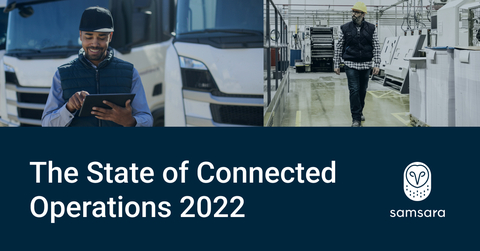New Samsara Research: Digitization Improves Business Resilience and Profits for Operations Leaders
The inaugural State of Connected Operations Report by Samsara (NYSE: IOT) reveals insights from over 1,500 operations leaders. Key findings indicate that 95% believe digitization enhances resilience, while 91% report increased profits from digital investments. Connected Operations Leaders are nearly twice as likely to exceed revenue goals compared to early-stage digitizers. The report highlights a critical shift towards AI and automation, with 90% planning to adopt these technologies by 2023, leading to better employee retention and satisfaction.
- 95% of operations leaders agree that digitization improves ability to weather disruptions.
- 91% report increased net profit from investments in digital technology.
- Connected Operations Leaders were nearly 2x more likely to exceed revenue goals compared to those at early stages of digitization.
- 90% expect to increase employee retention due to AI and automation.
- None.
Insights
Analyzing...
Inaugural State of
-
95% of surveyed operations leaders agreed digitizing operations improves their ability to weather disruptions -
91% stated investments in digital technology increased net profit -
95% that have implemented AI and automation report increased employee retention -
85% said increasing the sustainability of their operations is a high or critical priority

(Graphic: Business Wire)
“Operations leaders are managing through a turbulent time marked by record inflation, rising interest rates, and immense supply chain pressure. While they have a long history of surviving challenging economic cycles, what’s different this time is the advantage of digitization,” said
Business Resilience and Profitability Hinge on Digital Transformation
The supply chain model that operators trusted broke during the COVID-19 pandemic. The global economy’s most important industries have since faced historic levels of disruption. Leaders seek restoration but also a fundamental change in their operations that will provide resilience in the decades to come. Digitization is enabling new agility as leaders can assess and respond based on real-time data. Samsara found that
Connected Operations Leaders are reaping the financial benefits of digital transformation, as
Legacy systems are holding organizations back and siloed data is compounding problems;
The Industrial Workforce Demands Modern Tools and Flexibility
Operations leaders are not immune to the Great Resignation and extremely tight labor markets. Zeroing in on one country and industry, consider if every unemployed person with experience in the durable goods manufacturing industry in
The industrial workforce has new demands–modern tools that increase safety, improve workflows, and stack up to the technologies they use in their personal lives. Samsara found the top influential factors for recruiting and retaining employees were improving workplace safety (
The era of remote work has left a lasting imprint on physical operations. Almost all respondents (
Connected Operations Leaders quickly adapted to this shift and were 6.5x more likely to offer remote work technologies to all of their employees compared to respondents in the beginning stage of digitization. Organizations with antiquated ways of working and a lack of response to workforce demands will find it difficult to retain employees and attract the digital natives that are quickly making up the labor market.
AI and Automation Bolster Employee Retention and Satisfaction
Applications of artificial intelligence (AI) and automation—such as AI cameras and automated workflows—have become vital for physical operations. For example, AI dash cameras are increasing safety on the road and exonerating drivers against false claims, which can reduce costs by hundreds of thousands of dollars for an organization.
Samsara found that
Other benefits respondents indicated include greater business agility (
Fuel Costs Shock EV Adoption Urgency
Soaring fuel prices have shaken global industrial operations. The sudden increase brought supply chain costs to new levels and has caused a downstream effect on consumer prices. This has led operations leaders to re-evaluate their investments in vehicle types. In response to rising fuel prices, nearly half (
Technology is playing an important role in transitioning fleets to EVs while increasing fuel economy today. For example, by tracking electrification criteria like average and max miles driven, fuel costs, and more, organizations can identify which vehicles are most qualified for replacement with EVs. In addition, telematics solutions with real-time GPS tracking and remote vehicle diagnostics can help plan the most efficient routes.
Both of these strategies can greatly impact an organization’s larger sustainability pursuits. Sustainability has become a top priority due to societal demands but predominantly because it’s good for business. For those that have a sustainability program in place, the top-reported benefits are increased access to business opportunities (
Increasing the sustainability of their operations is a high or critical priority for
The Time is Now for the Rise of Connected Operations
Of the 1,500+ operations leaders Samsara surveyed, only
Biswas added, “The digital transformation of physical operations is a multi-decade shift that will save lives, reduce carbon emissions, and keep the flow of goods, services, and people moving. Connected operations can guide greater profitability, higher employee satisfaction and retention, increased access to business opportunities, and a more sustainable future.”
To learn more about the State of Connected Operations Report, please visit Samsara here.
About the Research
The 2022 State of Connected Operations survey was conducted by an independent research firm,
About Samsara
Samsara is the pioneer of the Connected Operations Cloud, which allows businesses that depend on physical operations to harness IoT (Internet of Things) data to develop actionable business insights and improve their operations. Samsara operates in
Samsara is a registered trademark of
View source version on businesswire.com: https://www.businesswire.com/news/home/20220615005376/en/
media@samsara.com
Source: Samsara







